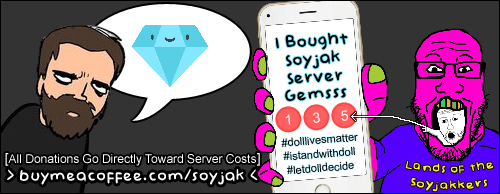- Joined
- Oct 15, 2024
- Messages
- 3,947
Reposting what I posted in the original thread where Ytsuken got banned:
Years ago, WorldNetDaily tried unsuccessfully to raise a bunch of hell over the fact that Wikipedia hosted a low-quality copy of the notorious original cover for Virgin Killer by the Scorpions, which depicts a naked 11-year-old girl doing a split. Wikipedians held a debate on whether to keep the image and decided that it should remain up. The cover for Blind Faith's 1969 self-titled album, which also depicts a naked preteen girl, is still up on Wikipedia as well. The Blind Faith cover is at least not sexualized, but the Scorpions cover is 100% child pornography and should have resulted in arrests of everyone involved in making it. That sort of thing, however, was far from unusual for its time. The proliferation of pedophilia in the '70s is something about the decade that many people willingly opt to forget, but it's something that definitely needs to be analyzed (and definitely needs to be prevented from happening again).
Of all of the countless films to get banned around the world over the years, one of the only ones that there is a completely legitimate justification for banning is the 1977 film Maladolescenza. This film contains some of the most graphic sexual imagery of children in cinema history, and has been banned as child porn in multiple countries. It's never been tried in US courts, but I have absolutely no doubt that it easily meets the American legal criteria for child porn (even in the '70s, it's pretty hard to believe that the filmmakers weren't charged with sexual abuse of children). In 1976, one of the little girls who starred in Maladolescenza - Eva Ionesco - actually appeared in a nude centerfold in the Italian version of Playboy at the age of 11. She also appeared nude in Penthouse and Der Spiegel as a preteen. Seriously - look it up if you don't believe me. The girl's mother widely distributed nude photos of her. The '70s were a very different time indeed. In fact, child porn was actually legal in the '70s. Child porn films were shown in porno theaters and child porn magazines were sold in sex shops. Child porn remained legal in Japan until 1999, and it was only made illegal there because of pressure from the US.
The 1971 Japanese New Wave experimental film Emperor Tomato Ketchup is another '70s arthouse film containing explicit sexual imagery of child actors - imagery that, if done today, would result in the filmmakers being immediately arrested (and rightfully so). Years back, the plug was pulled on a planned Canadian screening of the film at a film festival. No distributor will touch this film with a 50-foot pole, and it's very easy to see why. The Danish gay coming-of-age romance film You Are Not Alone (1978) depicts a 12-year-old boy and a 16-year-old boy in an extended shower scene where full-frontal nudity of both of them is shown and the two eventually share a hug while still naked. In 2018, it was revealed that, unsurprisingly, all of the children who worked on that film were sexually abused by the film's producers. The Swedish film Barnens ö (1980) got banned in Australia in 2013 because it depicts a 12-year-old boy masturbating for real in explicit detail. One of my favorite art-shock films from the '70s - Sweet Movie (1974) - contains a scene where a woman grinds her naked vagina into the faces of numerous small children (and no, I will not defend that scene). Nagisa Oshima's 1976 masterpiece In the Realm of the Senses contains a scene where a woman pulls on a little boy's penis in very graphic detail (this is meant to represent her sexual obsession, but it's not defensible either). The 1979 film The Tin Drum - widely considered a classic of world cinema - was embrangled in a child porn controversy in the US in the 2000s, because it also depicts some imagery of children that would not fly today. Pretty Baby (1978) is the most well-known example of imagery of children that would not fly today, with a then-11-year-old Brooke Shields playing a child prostitute who, at one point, appears nude on screen. The 1991 Belgian film Sexuelle voorlichting - a sex-ed film meant to be shown to kids - contains extremely explicit (and completely genuine) sexual imagery of children. That film has long been a favorite among pedophiles, since it's a legal way for them to watch child porn (although it certainly shouldn't be legal - "sex-ed" is no excuse for child porn). There was a Blogspot site dedicated to "Child Nudity in Films" that the pedos over at 4cuck's /tv/ board were quite fond of. IDK if that site is still up or not (hopefully not). The site Mr. Skin - dedicated to female nudity in films - doesn't feature 11-year-old Brooke Shields's infamous nude scene in Pretty Baby, but does feature all of the nudity from Maladolescenza, along with the nude pictures that preteen Eva Ionesco's mother distributed of her (describing said pictures as "too hot to handle").
Years ago, WorldNetDaily tried unsuccessfully to raise a bunch of hell over the fact that Wikipedia hosted a low-quality copy of the notorious original cover for Virgin Killer by the Scorpions, which depicts a naked 11-year-old girl doing a split. Wikipedians held a debate on whether to keep the image and decided that it should remain up. The cover for Blind Faith's 1969 self-titled album, which also depicts a naked preteen girl, is still up on Wikipedia as well. The Blind Faith cover is at least not sexualized, but the Scorpions cover is 100% child pornography and should have resulted in arrests of everyone involved in making it. That sort of thing, however, was far from unusual for its time. The proliferation of pedophilia in the '70s is something about the decade that many people willingly opt to forget, but it's something that definitely needs to be analyzed (and definitely needs to be prevented from happening again).
Of all of the countless films to get banned around the world over the years, one of the only ones that there is a completely legitimate justification for banning is the 1977 film Maladolescenza. This film contains some of the most graphic sexual imagery of children in cinema history, and has been banned as child porn in multiple countries. It's never been tried in US courts, but I have absolutely no doubt that it easily meets the American legal criteria for child porn (even in the '70s, it's pretty hard to believe that the filmmakers weren't charged with sexual abuse of children). In 1976, one of the little girls who starred in Maladolescenza - Eva Ionesco - actually appeared in a nude centerfold in the Italian version of Playboy at the age of 11. She also appeared nude in Penthouse and Der Spiegel as a preteen. Seriously - look it up if you don't believe me. The girl's mother widely distributed nude photos of her. The '70s were a very different time indeed. In fact, child porn was actually legal in the '70s. Child porn films were shown in porno theaters and child porn magazines were sold in sex shops. Child porn remained legal in Japan until 1999, and it was only made illegal there because of pressure from the US.
The 1971 Japanese New Wave experimental film Emperor Tomato Ketchup is another '70s arthouse film containing explicit sexual imagery of child actors - imagery that, if done today, would result in the filmmakers being immediately arrested (and rightfully so). Years back, the plug was pulled on a planned Canadian screening of the film at a film festival. No distributor will touch this film with a 50-foot pole, and it's very easy to see why. The Danish gay coming-of-age romance film You Are Not Alone (1978) depicts a 12-year-old boy and a 16-year-old boy in an extended shower scene where full-frontal nudity of both of them is shown and the two eventually share a hug while still naked. In 2018, it was revealed that, unsurprisingly, all of the children who worked on that film were sexually abused by the film's producers. The Swedish film Barnens ö (1980) got banned in Australia in 2013 because it depicts a 12-year-old boy masturbating for real in explicit detail. One of my favorite art-shock films from the '70s - Sweet Movie (1974) - contains a scene where a woman grinds her naked vagina into the faces of numerous small children (and no, I will not defend that scene). Nagisa Oshima's 1976 masterpiece In the Realm of the Senses contains a scene where a woman pulls on a little boy's penis in very graphic detail (this is meant to represent her sexual obsession, but it's not defensible either). The 1979 film The Tin Drum - widely considered a classic of world cinema - was embrangled in a child porn controversy in the US in the 2000s, because it also depicts some imagery of children that would not fly today. Pretty Baby (1978) is the most well-known example of imagery of children that would not fly today, with a then-11-year-old Brooke Shields playing a child prostitute who, at one point, appears nude on screen. The 1991 Belgian film Sexuelle voorlichting - a sex-ed film meant to be shown to kids - contains extremely explicit (and completely genuine) sexual imagery of children. That film has long been a favorite among pedophiles, since it's a legal way for them to watch child porn (although it certainly shouldn't be legal - "sex-ed" is no excuse for child porn). There was a Blogspot site dedicated to "Child Nudity in Films" that the pedos over at 4cuck's /tv/ board were quite fond of. IDK if that site is still up or not (hopefully not). The site Mr. Skin - dedicated to female nudity in films - doesn't feature 11-year-old Brooke Shields's infamous nude scene in Pretty Baby, but does feature all of the nudity from Maladolescenza, along with the nude pictures that preteen Eva Ionesco's mother distributed of her (describing said pictures as "too hot to handle").
Last edited:


